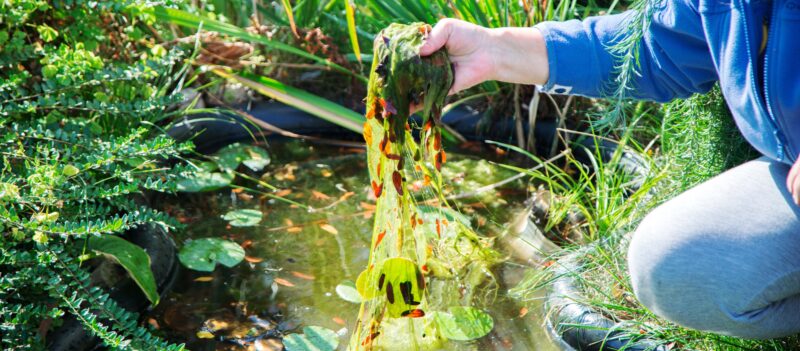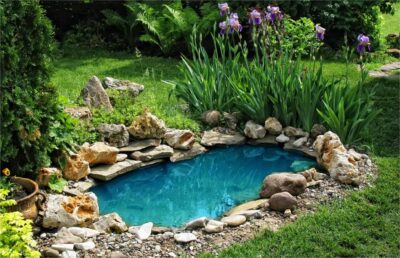There are more than 150,000 types of algae in the world. Depending on the species, they can live in different environments and under various conditions. It is necessary to dissociate floating algae, and filamentous algae and it is possible to treat with different solutions. In this article i will explain how to control the amount of filamentous algae from your garden pond.
These filamentous algae exist in different forms in your garden pond. They can make filaments of more than 2M long. These algae are not always pretty, but did you know that Koi carp love to spawn in filamentous algae?
In ponds, there are several groups of algae. There are microscopic algae, which float freely in the water and color the water green, and filamentous algae, which form long trails.

As the name suggests, filamentous algae form filaments. They are long green threads that cling to the walls and plants. From a distance, they look a bit like clouds. In a later stage of their growth, they detach and drift in the form of plates. Their color ranges from khaki green to brown to yellow and finally to a kind of disgusting mush. When filamentous algae are present, the water is often clear or very clear.
Unlike floating algae, filamentous algae is not a bad sign. They are satisfied with a very small amount of nutrients (phosphates). After the winter, there are always nitrate residues in the pond water. The filamentous algae take advantage of this to grow until the nitrate is gone. They then stop growing, break off and form slippery yellow-brown-green balls that float on the surface of the water.
How is the algae problem caused?
Algae growth occurs because aquatic plants are not able to completely remove nutrients from the pond. A surplus of nutrients is created which the algae take advantage of. Microscopic algae are always present in a latent state and grow very fast. Unlike other plants, they are not demanding in terms of water quality.
How do I remove algae from my pond?
There is nothing more annoying than an excess of algae in the pond. A pond is a closed ecosystem. Biological waste is converted by bacteria into nutrients for aquatic plants, which in turn release oxygen into the water, resulting in a healthy pond environment.
Even when the pond has been well designed, problems can occur that upset the biological balance. This can lead to unwanted algae growth.

How to control filamentous algae from my garden pond?
We have some tips to counteract algae formation.
- Place more pond plants
- Use bacteria that will digest nutrients
- Avoid bottom waste and clean the filter.
- Your fish should eat everything quickly.
- Remove as much algae as possible by hand
- Monitor your water quality
- Use an algae treatment
Filamentous Algae Control in a Pond
The first step to having an algae free pond is to test the water and based on the result, a diagnosis and plan to remove the algae can be made. For the pond environment a knowledge of the pH-value is essential because it tells us what the CO2 content of the water is. If in the morning the pH value is relatively low (pH 7-8) and in the evening it is relatively high (pH 8-9), then the pond environment is working, the plants will grow well and the water will be clear.
The use of peat aggregate can accelerate the decrease of the pH-value. If the pH-value is too low (pH 6 and below), the pond environment becomes acidic and threatens all inhabitants of the pond. Especially during the winter, low pH values can occur under certain conditions.
The general hardness of the water is determined by calcium and magnesium. This becomes the GH value of the water. A good GH value for pond water is between 8° and 12° dH. Most pond plants grow optimally in these values and the development and activity of microorganisms is optimal in this medium hard water.
Carbonate hardness (KH value) is an important pillar in the pond environment. The KH value is also called temporary hardness. It is also referred to as the antacid strength.
Excess nutrients in the water can have several causes:
- high a phosphate content
- too much food for the fish
- Filled with fish
- not enough plants
- inadequate filtration
- poor bacteriological water balance
- insufficient water quality









